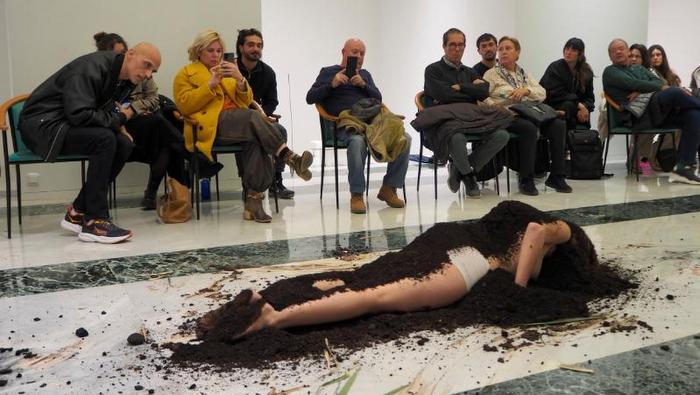A subtle tone pervades the space. The essence of a past temporality, a flutter of the senses, a trigger of distant memory. Dulcet yet melancholic, ‘Elegy’, Su-Mei Tse’s first solo show in Hong Kong, sets a pensive pace, a rhythm that invites self-reflection as well as a heightened awareness of one’s surroundings. Acting as punctuations throughout the gallery, the works behold an impact that extends beyond their visual properties; it is about their lasting impression, the reflection they heighten when seen, the experience sensed. ‘Elegy’ as an exhibition is an open score, presenting a set of triggers whilst inviting each viewer’s personal interpretation and impression.
A trained classical cellist of Chinese and British descent, Su-Mei Tse (b. 1973, Luxembourg) weaves a practice that spans video, installation, photography and sculpture to mount a meditative, visaural tale empowering the language of music as a primary voice. Investigating associations between places, geographies, cultures, traditions, Tse’s work elicits a cross-stimulation of the senses, where time and its flow are suspended in a gentle state of contemplation. As the exhibition title ‘Elegy’ suggests, Tse’s practice is underpinned by a strong sense of lyricism and musicality. Brought up by a violinist father and pianist mother, Tse equally grew up with music at the Luxembourg Conservatory. She maintained this duality when studying visual arts at the École Nationale des Beaux-Arts in Paris by accompanying her practice with musical studies.
As such, a bilingual versatility pervades Tse’s practice. ‘Elegy’ is at once a mysterious visual ballad and a delicate aesthetic encounter that one unravels, one step at a time. Inspired by, and developed during Tse’s recent residency at the Villa Medici, the viewer encounters photographs, moving images (video), objects, mirrors, references of collected memories that hark back but are not limited to her time in Rome. Each image reflects an emotion: the bust of Adriana - a hymn to past history, traced by the degradation of time whilst bearing delicacy of expression and detail; Gaelle – a friend and writer, a hint of her arm, remembrance of her graceful person, a reference to her feminine sensitivity, a particular moment at a farewell party. Creating links between each visuals are mirrors, aligning multiple captures along a singular sequence, one which changes dependent on the viewer’s position and perception.
Beyond this aspect of visual interplay, Tse builds a curious game of sonorous associations. Moving through the space, a delicate splatter reverberates throughout the gallery. Invisible at first instance to the eye, one is drawn to ‘The Pond’ as a possible source: a dual work composed of two photographs partially covered by glass and placed on the floor, the diptych presents nymphaeae appearing mysteriously from the depths of the water. Peering down, as one would in real life, a temptation lies of making a link between sound and aqueous element - upon second thought, however, the impossibility of digital emission settles. As such, one moves through the space till, around the bend, the answer is found; a fountain, jutting black ink fills the space. A hark to the architectural elements that dot the city of Rome, the liquid further drawing in a sense of poetry, of writing, of light yet burdened darkness.
Surrounding this final element are a range of mirrors, faded by the passing of time and the reality of weathering. It is within these levels of activity, from the captured moment in the photographs, the evolving reflections, to the furtive energy of flowing ink, that the viewer encounters the varying notes of ‘Elegy’. It is about the passing of time, which may be a flutter, a slow burn, a sequence, or a sequel. And in so experiencing these varying levels the viewer is released to consider what touches them, when, and how fleetingly or lastingly, it traces their everyday lives. Indeed, each is prompted to write and consider what would be their own ‘elegy’.
For the realisation of the exhibition, Su-Mei Tse worked in close collaboration with her partner Jean-Lou Majerus.
Su-Mei Tse is an internationally-celebrated artist who rose to prominence in 2003 when she represented Luxembourg at the Venice Biennale and was awarded the prestigious Leono d’Oro award for her tripartite installation ‘Air Conditioned’. Tse’s work has since been exhibited nationally and internationally including solo shows at Joan Miró Foundation, Barcelona (2011); Isabella Stewart Gardner Museum, Boston (2009); Art Tower Mito, Japan (2009); Seattle Art Museum, Seattle (2008); PS1, New York (2006); Casino, Forum d’Art Contemporain, Luxembourg (2006); Renaissance Society, Chicago (2005); Moderna Museet, Sweden (2004). Group exhibitions include Setouchi Triennalia, Japan (2016); Zentrum Paul Klee, Switzerland (2015); Hirschhorn Museum Washington DC (2014); Kunstmuseum Bonn, Germany (2009); Singapore Biennale (2008); Kunsthaus Zurich (2006); Sao Paulo Biennale (2004). Tse has additionally been the recipient of multiple prizes, including the Prize for Contemporary Art by the Foundation Prince Pierre of Monaco (2009) and the Edward Steichen Award, Luxembourg (2005).
Su-Mei Tse solo exhibition 'Elegy' opens 20 March















